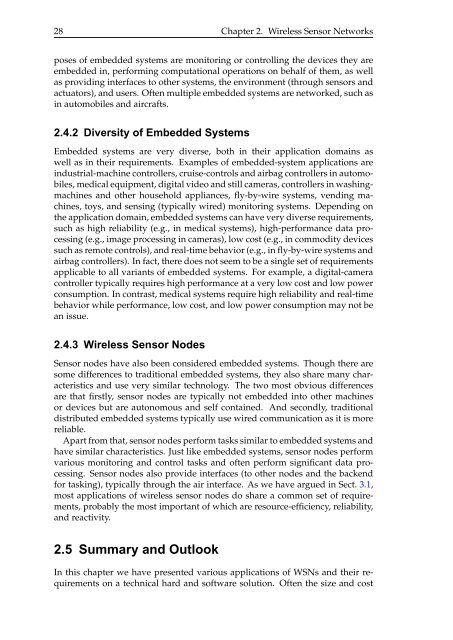A State-Based Programming Model for Wireless Sensor Networks
A State-Based Programming Model for Wireless Sensor Networks
A State-Based Programming Model for Wireless Sensor Networks
You also want an ePaper? Increase the reach of your titles
YUMPU automatically turns print PDFs into web optimized ePapers that Google loves.
28 Chapter 2. <strong>Wireless</strong> <strong>Sensor</strong> <strong>Networks</strong><br />
poses of embedded systems are monitoring or controlling the devices they are<br />
embedded in, per<strong>for</strong>ming computational operations on behalf of them, as well<br />
as providing interfaces to other systems, the environment (through sensors and<br />
actuators), and users. Often multiple embedded systems are networked, such as<br />
in automobiles and aircrafts.<br />
2.4.2 Diversity of Embedded Systems<br />
Embedded systems are very diverse, both in their application domains as<br />
well as in their requirements. Examples of embedded-system applications are<br />
industrial-machine controllers, cruise-controls and airbag controllers in automobiles,<br />
medical equipment, digital video and still cameras, controllers in washingmachines<br />
and other household appliances, fly-by-wire systems, vending machines,<br />
toys, and sensing (typically wired) monitoring systems. Depending on<br />
the application domain, embedded systems can have very diverse requirements,<br />
such as high reliability (e.g., in medical systems), high-per<strong>for</strong>mance data processing<br />
(e.g., image processing in cameras), low cost (e.g., in commodity devices<br />
such as remote controls), and real-time behavior (e.g., in fly-by-wire systems and<br />
airbag controllers). In fact, there does not seem to be a single set of requirements<br />
applicable to all variants of embedded systems. For example, a digital-camera<br />
controller typically requires high per<strong>for</strong>mance at a very low cost and low power<br />
consumption. In contrast, medical systems require high reliability and real-time<br />
behavior while per<strong>for</strong>mance, low cost, and low power consumption may not be<br />
an issue.<br />
2.4.3 <strong>Wireless</strong> <strong>Sensor</strong> Nodes<br />
<strong>Sensor</strong> nodes have also been considered embedded systems. Though there are<br />
some differences to traditional embedded systems, they also share many characteristics<br />
and use very similar technology. The two most obvious differences<br />
are that firstly, sensor nodes are typically not embedded into other machines<br />
or devices but are autonomous and self contained. And secondly, traditional<br />
distributed embedded systems typically use wired communication as it is more<br />
reliable.<br />
Apart from that, sensor nodes per<strong>for</strong>m tasks similar to embedded systems and<br />
have similar characteristics. Just like embedded systems, sensor nodes per<strong>for</strong>m<br />
various monitoring and control tasks and often per<strong>for</strong>m significant data processing.<br />
<strong>Sensor</strong> nodes also provide interfaces (to other nodes and the backend<br />
<strong>for</strong> tasking), typically through the air interface. As we have argued in Sect. 3.1,<br />
most applications of wireless sensor nodes do share a common set of requirements,<br />
probably the most important of which are resource-efficiency, reliability,<br />
and reactivity.<br />
2.5 Summary and Outlook<br />
In this chapter we have presented various applications of WSNs and their requirements<br />
on a technical hard and software solution. Often the size and cost
















